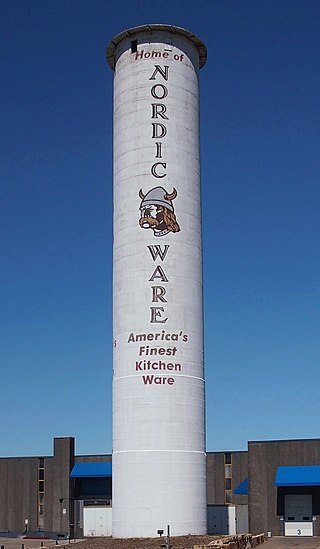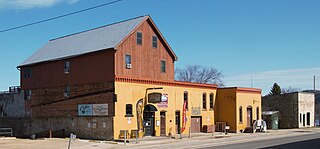
A grain elevator is a facility designed to stockpile or store grain. In the grain trade, the term "grain elevator" also describes a tower containing a bucket elevator or a pneumatic conveyor, which scoops up grain from a lower level and deposits it in a silo or other storage facility.

Wayne Junction station is a SEPTA Regional Rail junction station located at 4481 Wayne Avenue, extending along Windrim Avenue to Germantown Avenue. The station is located in the Nicetown neighborhood of Philadelphia. Wayne Junction serves as a multi-modal transfer point between six of SEPTA's regional rail lines as well as three major transit routes – the Route 75 Trackless Trolley and the Route 23 and 53 bus lines. The station served more than 321,000 riders annually in 2018.

The Peavey–Haglin Experimental Concrete Grain Elevator is the world's first known cylindrical concrete grain elevator. It was built from 1899 to 1900 in St. Louis Park, Minnesota, United States, as an experiment to prove the design was viable. It was an improvement on wooden elevators that were continually at risk of catching fire or even exploding. Its cylindrical concrete design became the industry standard in the United States, revolutionizing grain storage practices. After its initial experiments, the Peavey–Haglin Elevator was never again used to store grain. Since the late 1960s it has been maintained on the grounds of the Nordic Ware company and is painted with their name and logo.
The Galt Historic Railway Park, collects, preserves, restores, exhibits and interprets artifacts which represent the history and social impact of the "steam" era in southern Alberta and the coal era, with emphasis on Galt Railway and the 1890 International Train Station Depot North West Territories from Coutts/Sweetgrass.

Armour's Warehouse, also known as the Seneca Grain Elevator or the Hogan's North Elevator, is a historic grain elevator located in the village of Seneca, Illinois, United States. The elevator and two surrounding outbuildings were listed on the U.S. National Register of Historic Places in 1997.

Silo Point, formerly known as the Baltimore and Ohio Locust Point Grain Terminal Elevator, is a residential complex converted from a high-rise grain elevator on the edge of the Locust Point neighborhood in Baltimore, Maryland. When the original grain elevator was opened in September 1924, it was the largest and fastest in the world. The first shipment of grain was processed on September 18, 1924. The condominium rises to 300 feet. The grain elevator was built by the Baltimore and Ohio Railroad in 1923–1924, with a capacity of 3.8 million bushels. In 2009 it had been converted from a grain elevator to a condominium tower containing 24 floors and 228 condominiums by Turner Development Group and architect Parameter, Inc.

Concrete-Central Elevator is a historic grain elevator located on the Buffalo River at 175 Buffalo River Buffalo in Erie County, New York.

Wollenberg Grain and Seed Elevator was a historic grain and seed elevator located at Buffalo in Erie County, New York. It was built in 1912 and remained in service until 1987. It was notable as the sole surviving example of a wooden or so-called "country style" elevator. It was built in the style of the earliest elevators dating to the 1840s and had a capacity of 25,000 bushels.

The Enid Terminal Grain Elevators Historic District is located in Enid, Garfield County, Oklahoma and listed on the National Register of Historic Places since 2009. The district consists of concrete grain elevators located between North 10th, North 16th, North Van Buren, and Willow Streets which have dotted the Enid skyline since the 1920s.
The Baker Woodframe Grain Elevator is a historic grain elevator in Baker, Oklahoma. The wood frame elevator was built in 1926 along the Beaver, Meade and Englewood Railroad by the Riffe & Gilmore Company. The elevator operated continuously from its opening until the early 1980s. Modern grain trucks proved to be too large for it in the mid 80's. Additional construction of steel bins to the west were added making the elevator an overflow storage. Over the years it has ceased operations yielding to the steel bins around it. The Riffe Gilmore location does still operate to this day, being one of very few still operating under the name, nearing 100 years of continued operations.

Shawmont is a former train station in Philadelphia, Pennsylvania. It is located on Nixon Street in the Roxborough section of Lower Northwest Philadelphia. Built by the Philadelphia, Germantown and Norristown Railroad, it later became part of the Reading Railroad and ultimately SEPTA Regional Rail's R6 Norristown Line. SEPTA made the station a whistle stop and closed its waiting room in 1991. SEPTA later closed the station in 1996. In 2018, $1 million was set aside for repairs and rehabilitation.

G. Kerndt and Brothers Elevator and Warehouses, No. 11, No.12 and No. 13 is a historic complex located in Lansing, Iowa, United States. The four Kerndt brothers were all German immigrants who settled in the Lansing area by 1854. Gustav, William and Mortiz established a broom factory and cigar business in town while Herman farmed and provided the broom corn for the factory. A fifth brother, Julian, died shortly after arriving in Iowa. They built their first grain warehouse in the late 1850s. In 1861 they began their general store, which would in time include private banking as a part of their mercantile business. In 1908 it was incorporated by the family as the Kerndt Brothers Savings Bank.
The Floris Grain Elevator, located off U.S. Route 64 in Floris, Oklahoma, was built in 1900 or 1926.

The Knowles Grain Elevator, located on U.S. Route 64 in Knowles, Oklahoma, was built in 1913. It was listed on the National Register of Historic Places in 1983.
The Turpin Grain Elevator, located off U.S. Route 64 in Turpin, Oklahoma, was built in 1925. It was listed on the National Register of Historic Places in 1983.
The Ross Grain Elevator is a historic building located in Ross, Iowa, United States. It was built in 1881 by Charles Stuart, a Civil War veteran who was a forwarding agent for the Chicago and Northwestern Railroad. The wooden structure rests on a limestone foundation. By the early 20th century the elevator was sheathed in corrigated steel to guard against the sparks that came off of the locomotives at the nearby depot, no longer extant. The elevator is made up of three interconnected buildings that include the elevator itself, an annex, and the brick scale-engine house. At one time the property contained two grain elevators, a depot, stock yards, cob houses, town dump, coal shed and other related structures. The railroad discontinued operations here in the 1940s, and the other buildings were removed over the years. The elevator itself was used on a farm into the 1970s. It has not been used since then, but its internal mechanisms are still extant. The elevator was listed on the National Register of Historic Places in 2018.

The Oneida Milling and Elevator Company Grain Elevator, in Power County, Idaho near American Falls, Idaho, was built in 1912. It was listed on the National Register of Historic Places in 1993.

The H.A. Baxter Coal Company Historic District, also known as C.E. Phillips Coal and Grain and Freshwaters Coal and Supply, is a nationally recognized historic district located in Washington, Iowa, United States. It was listed on the National Register of Historic Places in 2015. At the time of its nomination it contained six resources, which included four contributing buildings, one contributing structure, and one non-contributing structure. By 1910 there were five businesses in Washington that sold coal to retail customers. All of them sold coal in conjunction with at least one other commodity. Henry A. Baxter was a dealer in coal, grain, and building materials. Baxter bought a grain elevator, no longer extant, on this site in 1903. He then had new buildings constructed in the 1910s and 1920s. Baxter was the only coal dealer in town that operated a coal elevator. Baxter died in 1929, and his company continued to operate through the 1930s. It became the Palmer Coal Company and Bush Coal Company in the early 1940s. Howard F. Freshwaters bought the property in 1945. Freshwaters Coal and Supply operated here from 1945 to 1959. Coal usage declined through the 1950s as natural gas replaced it for heating buildings. In 1959, Freshwaters Feed and Grain Company moved to this location from downtown. They continued to offer coal for sale into the early 1970s, and they were the last business in Washington to do so.
The Beaver, Meade and Englewood Railroad (BM&E) extended from Beaver, Oklahoma to Keyes, Oklahoma in the Oklahoma Panhandle, about 105 miles. It was chartered in 1912, and abandoned in 1972.


















